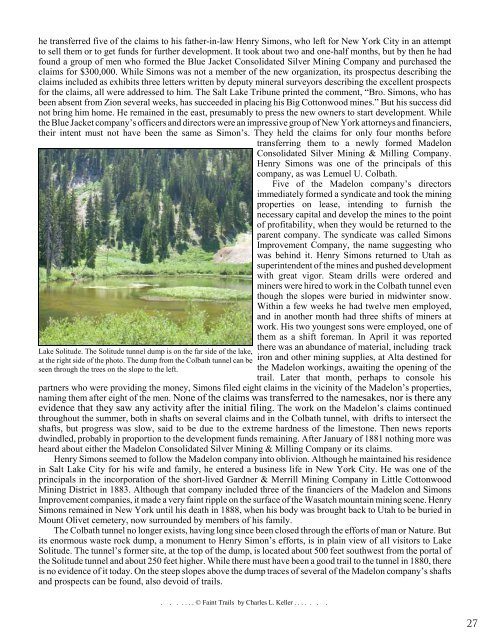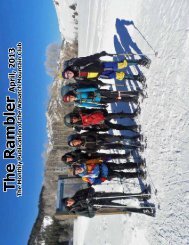The Rambler
Oct - Wasatch Mountain Club
Oct - Wasatch Mountain Club
- No tags were found...
You also want an ePaper? Increase the reach of your titles
YUMPU automatically turns print PDFs into web optimized ePapers that Google loves.
he transferred five of the claims to his father-in-law Henry Simons, who left for New York City in an attempt<br />
to sell them or to get funds for further development. It took about two and one-half months, but by then he had<br />
found a group of men who formed the Blue Jacket Consolidated Silver Mining Company and purchased the<br />
claims for $300,000. While Simons was not a member of the new organization, its prospectus describing the<br />
claims included as exhibits three letters written by deputy mineral surveyors describing the excellent prospects<br />
for the claims, all were addressed to him. <strong>The</strong> Salt Lake Tribune printed the comment, “Bro. Simons, who has<br />
been absent from Zion several weeks, has succeeded in placing his Big Cottonwood mines.” But his success did<br />
not bring him home. He remained in the east, presumably to press the new owners to start development. While<br />
the Blue Jacket company’s officers and directors were an impressive group of New York attorneys and financiers,<br />
their intent must not have been the same as Simon’s. <strong>The</strong>y held the claims for only four months before<br />
transferring them to a newly formed Madelon<br />
Consolidated Silver Mining & Milling Company.<br />
Henry Simons was one of the principals of this<br />
company, as was Lemuel U. Colbath.<br />
Five of the Madelon company’s directors<br />
immediately formed a syndicate and took the mining<br />
properties on lease, intending to furnish the<br />
necessary capital and develop the mines to the point<br />
of profitability, when they would be returned to the<br />
parent company. <strong>The</strong> syndicate was called Simons<br />
Improvement Company, the name suggesting who<br />
was behind it. Henry Simons returned to Utah as<br />
superintendent of the mines and pushed development<br />
with great vigor. Steam drills were ordered and<br />
miners were hired to work in the Colbath tunnel even<br />
though the slopes were buried in midwinter snow.<br />
Within a few weeks he had twelve men employed,<br />
and in another month had three shifts of miners at<br />
work. His two youngest sons were employed, one of<br />
them as a shift foreman. In April it was reported<br />
Lake Solitude. <strong>The</strong> Solitude tunnel dump is on the far side of the lake,<br />
at the right side of the photo. <strong>The</strong> dump from the Colbath tunnel can be<br />
seen through the trees on the slope to the left.<br />
there was an abundance of material, including track<br />
iron and other mining supplies, at Alta destined for<br />
the Madelon workings, awaiting the opening of the<br />
trail. Later that month, perhaps to console his<br />
partners who were providing the money, Simons filed eight claims in the vicinity of the Madelon’s properties,<br />
naming them after eight of the men. None of the claims was transferred to the namesakes, nor is there any<br />
evidence that they saw any activity after the initial filing. <strong>The</strong> work on the Madelon’s claims continued<br />
throughout the summer, both in shafts on several claims and in the Colbath tunnel, with drifts to intersect the<br />
shafts, but progress was slow, said to be due to the extreme hardness of the limestone. <strong>The</strong>n news reports<br />
dwindled, probably in proportion to the development funds remaining. After January of 1881 nothing more was<br />
heard about either the Madelon Consolidated Silver Mining & Milling Company or its claims.<br />
Henry Simons seemed to follow the Madelon company into oblivion. Although he maintained his residence<br />
in Salt Lake City for his wife and family, he entered a business life in New York City. He was one of the<br />
principals in the incorporation of the short-lived Gardner & Merrill Mining Company in Little Cottonwood<br />
Mining District in 1883. Although that company included three of the financiers of the Madelon and Simons<br />
Improvement companies, it made a very faint ripple on the surface of the Wasatch mountain mining scene. Henry<br />
Simons remained in New York until his death in 1888, when his body was brought back to Utah to be buried in<br />
Mount Olivet cemetery, now surrounded by members of his family.<br />
<strong>The</strong> Colbath tunnel no longer exists, having long since been closed through the efforts of man or Nature. But<br />
its enormous waste rock dump, a monument to Henry Simon’s efforts, is in plain view of all visitors to Lake<br />
Solitude. <strong>The</strong> tunnel’s former site, at the top of the dump, is located about 500 feet southwest from the portal of<br />
the Solitude tunnel and about 250 feet higher. While there must have been a good trail to the tunnel in 1880, there<br />
is no evidence of it today. On the steep slopes above the dump traces of several of the Madelon company’s shafts<br />
and prospects can be found, also devoid of trails.<br />
. . . . . . . © Faint Trails by Charles L. Keller . . . . . . .<br />
27
















